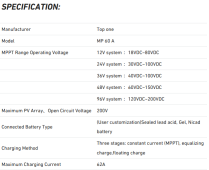Looking at the specs of your controller, this is what I see...
View attachment 154488
This is the very first time I've seen a controller with different maximal voltages. Usually I see maximal amps varying from one system voltage to another. Although I see the unit have a max Voc listed as 200V, I would be hesitant to recommend wiring a panel string anywhere near that high.
My gut feeling is that you should treat the 80VDC value for 12V as the max Voc? Maybe someone that actually has this controller can chime in to give more experienced advice.
In any case, 4 of your panels, wired in series, I think would work with this controller. The Voc at room temp is going to bump up to 79.3V, but could easily go past 88V on a frosty morning. Since you are in Alberta, that could easily bump past 99V at -40 degrees.
To be really, really conservative, assuming you never want the Voc to pass 80V, then wire a max of only three of those panels in series. The Voc at -40 degrees will only be 74V. It might be very worthwhile to communicate with the manufacturer to really pin down what exactly the max voltage for a 12V system can be.
One other way to increase your solar input without exceeding these very conservative Voc limits is to use virtual tracking. Get 6 of those panels and wire them 3S2P, but face one array Southeast, while the other array faces Southwest. Since neither array is at maximal power at the same time, that will safely keep you below your amp limit.




